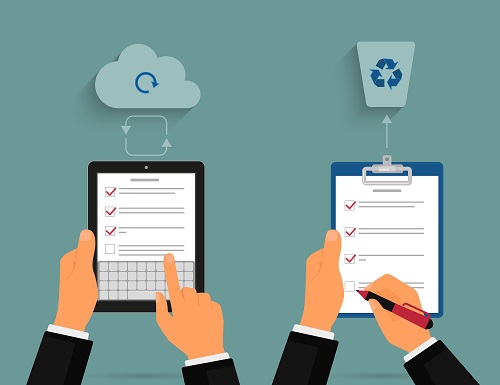
By Irene Bonin, Hayes Management Consulting
Twitter: @HayesManagement
Ever heard the phrase “tech savvy”? Or “Information Age”? These are the times we live in. Everything is going electronic; from mail and photos to cars and phones. It seems like everyone knows the newer, faster gadget and how to use it. Along with the rest of the world, medical records and doctor’s visits are being taken electronic and, not surprisingly, the “digital generation” appears in the healthcare industry, as well. There are more and more people who have never worked on paper, only electronic health record systems (EHRs). But what happens if the system crashes? Or when the power goes out? Does patient care stop? Absolutely not. What happens to those tech savvy fishes when they’re tossed out of their electronic water and onto the stationery ground? Users sometimes struggle with the workflows using classic tools of paper and pen. These struggles then manifest as delayed patient care, frustration and anxiety. How can you ensure your organization is prepared for an unplanned downtime?
The answer is to P-L-A-N:
- Policy/Procedure/Prepare/Practice
- Learn
- Accountability
- Necessary documentation
These four key steps will ensure your organization can successfully ride through an unplanned downtime. Sometimes we become so dependent on electronic systems that we don’t think about what to do if that is temporarily taken away. The more you plan, however, the more you will be prepared for the unexpected.
P: Policy, Procedure, Prepare, Practice.
Policy drives standardized workflows and gives staff guidelines. Downtime can happen at 2 am on a holiday weekend and if a strong policy/procedure is in place, users will have clear instructions to navigate through the downtime. Just like checking the code cart every shift in preparation for an emergency, downtime drills are just as important. Have users, on a regular basis, check downtime computers: are they plugged in, do users know how to use them, and are they connected to a printer? In one organization, the staff unplugged the keyboard and mouse and stored them in a cupboard to free up counter space. Education is essential for this equipment to assure it is always ready. Organizations that have been prepared have created a downtime sub-group to keep their users up-to-date on downtime procedures. Toolkits are set up and maintained by these groups to ensure that any paper documents are available if printing is offline, as well. Things to include in these toolkits are prescription pads, pens, generic order sheets, discharge instructions and most up-to-date downtime policy and procedures.
L: Learn from previous unplanned down times.
As soon as systems are stabilized, pull together your leadership team from operations and hold a Root Cause Analysis (RCA). Ask the “whys” and evaluate the responses. Identify the weaknesses in your policy and procedures because your organization is only as strong as your weakest process. Was there a service or department that struggled? Your providers can place the order, the nurse can collect the specimen, it can be sent to the lab, but if the lab does not have a clear understanding of how to report the findings back to the provider, the workflow has failed. Document the RCA clearly and assign action items so that there is follow up and ownership.
A: Accountability.
Accountability lends to clarification of process and procedure. Setting up a core team that will quickly come together once it is confirmed your EHR is down will set the tone of your event. Assign communicator roles to send out company-wide communication. Identify one person to run the “strategy room” or “war room”. This role will update leadership and facilitate communication between the in-house analyst and vendor resources, if needed.
N: Necessary documentation.
Communicate and clearly define what documentation is necessary to enter into the EHR once your organization is back online. Each organization must define this for each discipline and assure that the entries are completed prior to bringing the system back up. This is extremely important for new orders, allergies, medication administration and lines, drains and airways.
Allowing yourself to think outside of the EHR box will set your organization head and shoulders above those who only function within the parameters of an electronic system. Being flexible and knowledgeable is part of what it takes to successfully navigate unplanned downtime and following these four steps are absolutely crucial.
This article was originally published in Hayes’ Healthcare Blog and is republished here with permission.
